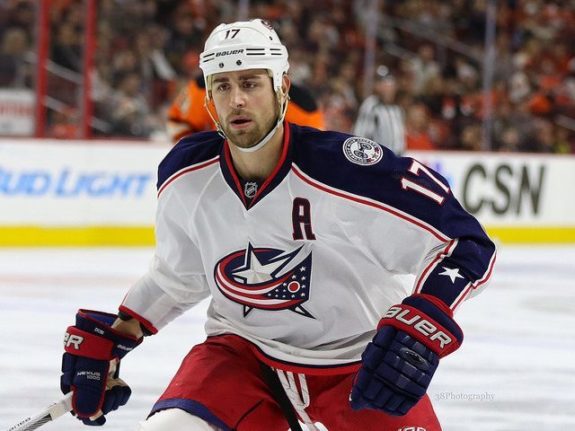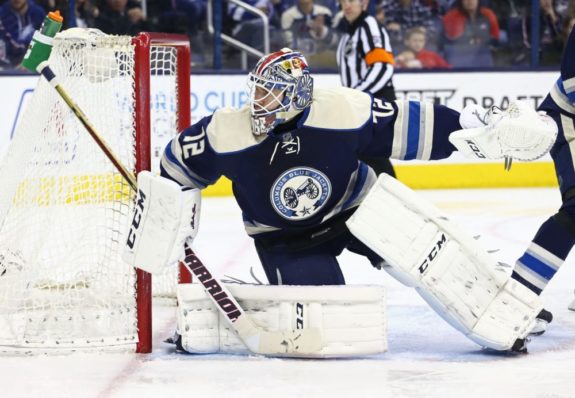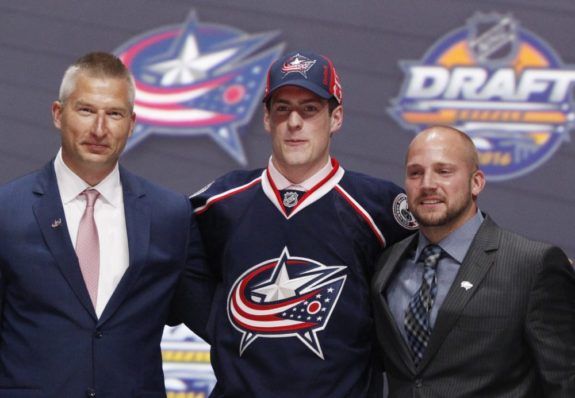We continue our summer series, titled Blue Jackets Pressure Points, on the Columbus Blue Jackets. We ask hard questions about the team and attempt to answer them as it relates to the upcoming season and beyond. Last time, we talked about what kind of season David Clarkson could have. Today, we turn our attention to the team’s biggest need by far: Can the Columbus Blue Jackets find success without a top center?
Once Upon A Time
Let’s take a trip down Blue Jackets memory lane for a moment. Remember when the team had “too many” centers?
At least that’s what many felt the team had at the time. The year was 2014. The Blue Jackets caught fire and blazed their way into the playoffs. A lot of things went right for them. At the top of this list was their depth at center.
The Blue Jackets had Ryan Johansen, Brandon Dubinsky, Artem Anisimov and Mark Letestu patrolling the middle of the ice. It’s no wonder that team made the playoffs. They had a legitimate, number one center in Johansen. And, they had excellent depth on all lines. The team also had Derek MacKenzie. Center was not an issue for this team.
Now look at the current state of the team. Of the five names mentioned above, only one, Dubinsky, is still on the team. Goodness. So much for that so-called “depth.”

The team decided not to re-sign Letestu and MacKenzie. They traded Anisimov to the Chicago Blackhawks in the Brandon Saad deal. They then traded their number one center Johansen to Nashville for defenseman Seth Jones. In Saad and Jones, the Blue Jackets landed great players. But they left a gaping hole down the middle.
On the current roster, the list of centers includes Dubinsky, Boone Jenner, Alexander Wennberg, Sam Gagner, William Karlsson and Gregory Campbell. Unfortunately for the Blue Jackets, there are no true, number one centers on this list. Dubinsky is the best in this group, and he’s a solid number two. Jenner in my mind is a better winger, but I list him here as the team may choose to put him at center. Jenner has number two upside if he stays at center. Wennberg is a solid three with two potential. Gagner, Karlsson and Campbell each project as bottom-six players.
That’s the problem. The Blue Jackets will likely start the season by playing a number two center as a number one. Dubinsky is a really good player. He can play on the top line. But he’s not Sidney Crosby, Anze Kopitar or Steven Stamkos. This is the disadvantage the Blue Jackets will play with this season.
We now ask the following question: Can the Columbus Blue Jackets find success this season without a true, number one center? The correct answer is yes, but…
Can The Blue Jackets Win Without a Top Center?
Anything is possible. That’s why you play the games. But this is a really tall order for the Columbus Blue Jackets. They can win games and they could make the playoffs. The issue is a lot of things have to go right for that to happen.

The onus is on the rest of the team. Every player has to pick up their own play to make up for the lack of a number one center. This starts in their own zone. Sergei Bobrovsky and the defense have to be the reason this team wins games. That’s a lot of pressure on a goalie trying to rebound from his worst season. That’s a lot of pressure on a young defense being asked to shut down the opposition’s best players night in and night out. The team finished 29th in goals against in 2015-16. Without a top center, this is where the Blue Jackets must see improvement.
The rest of the forwards also must step their game up. It will take a total team effort to bridge the sizable gap. Think of it this way: Not having a number one center means you don’t have a player who can effectively play both ends of the ice against the team’s best competition. That player can score 30 goals, while shutting the opposition down.
Here’s the real curious part to me. In the 41 games before the Johansen trade, the team scored 105 goals. In the 41 after, they scored 114. The Blue Jackets finished 17th in goals for last season. Granted, many of the games had nothing on the line. But still, the team increased their goals/game once Johansen was traded. They scored some goals, but were still ranked in the bottom half of the middle of the pack. If their 2.78 goals/game was for the entire season, they would have been tied for 12th overall in goals. They did have four players (Jenner, Saad, Atkinson, Hartnell) finish with 23 or more goals. This must continue without a true, number one center.

Need proof of the power of a number one center? Look at who has recently won a Stanley Cup. Crosby, Malkin, Kopitar, Toews, Bergeron, Krejci and Zetterberg represent the top centers who have won a Cup. There’s something to be said about their impact on making a championship run.
Now, does that mean you must have one to make the playoffs? It’s preferred but you can get to the playoffs without one. It means the rest of the team did enough to offset the gap. For the Columbus Blue Jackets, their playoff road map must include better defense and goaltending, combined with timely scoring. It’s a lot to ask of a young team, but it can happen.
Pierre-Luc Dubois could eventually become the Blue Jackets’ number one center. But that’s later. For now, the team must find their way without one. Can the team pick up the slack? They need to. Otherwise, it could be a long winter.